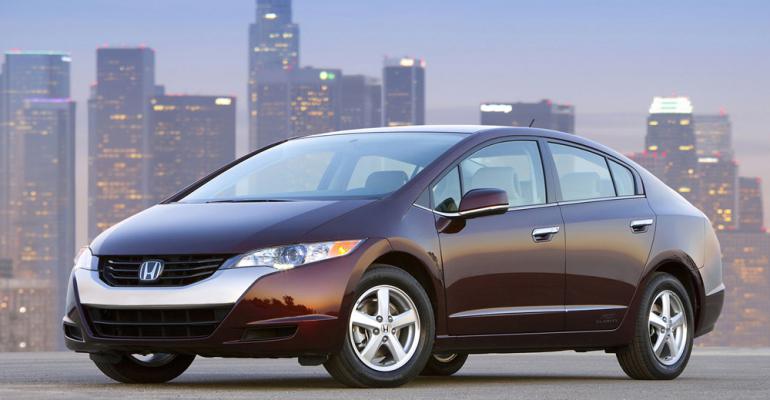General Motors and Honda will collaborate on a long-term program to develop hydrogen-fuel-cell systems and storage units with the goal of bringing the technology to market in the 2020 timeframe.
In jointly announcing the project today, the auto makers say they will share expertise, economies of scale and common sourcing strategies. They also will work together with other stakeholders to grow the refueling infrastructure.
The auto makers do not reveal how much money they’ll put behind the effort, although GM says it is hiring experts in the field.
Hydrogen-fuel-cell electric vehicles are seen as the best way to eliminate tailpipe emissions. But the sophisticated technology remains prohibitively expensive, because it uses precious metals as a catalyst to create electricity from hydrogen and onboard storage requires a durable fuel tank made of advanced materials rather than plastic.
The lack of infrastructure poses another problem. There are fewer than 25 hydrogen filling stations in California, and nationally there are only about 50 public, private and research stations either on line or under development.
A supply chain also must be built.
GM at one time thought it could bring an FCEV to market by the end of the previous decade, but the auto maker eventually stopped providing time-to-market estimates. It recently completed Project Driveway, where 119 Chevrolet Equinox cross/utility vehicles were lent to consumers for field testing that accumulated 3 million miles (4.8 million km).
Honda is the sole auto maker to sell a vehicle with the technology. The Japanese auto maker has leased 85 of its FCX and FCX Clarity models in the U.S. and its home country since 2002. It plans to launch the next-generation FCX Clarity in 2015. GM will announce its production plans at a later date.
“This collaboration builds upon Honda and GM’s strengths as leaders in hydrogen-fuel-cell technology,” GM Chairman and CEO Dan Akerson says in a statement. “We are convinced this is the best way to develop this important technology, which has the potential to help reduce the dependence on petroleum and establish sustainable mobility.”
Honda President and CEO Takanobu Ito says FCEVs represent the best zero-emission option, because range and refueling time is “as good as conventional gasoline cars.”
Plug-in EVs face the hurdle of limited range. Today’s models cannot travel more than 100 miles (160 km) without recharging. Recharging the cars can take hours. FCEVs, by comparison, can travel upwards of 400 miles (644 km) before requiring a few minutes of refueling. They emit only water vapor.
GM and Honda say they rank No.1 and No.2, respectively, in the number of patents filed related to the FCEV technology.
Sources say the two auto makers bring plenty of know-how to the table, although generally speaking Honda’s strength would be in manufacturing. GM’s expertise would be in the catalyst field, or putting the best chemistry together to create electricity from hydrogen.
Culturally, the two company believe they have a strong alignment between their teams. Both are powertrain-rooted companies.
The master agreement between GM and Honda comes as FCEVs are experiencing a bit of a rebirth. The technology was a darling in the industry a decade ago, but important policies, funding and research from the U.S. government shifted to battery-electric and plug-in hybrid vehicles.
FCEVs owe their resurgence to strict new fuel-economy and emissions regulations taking hold in global markets over the next few years. Auto makers selling in the U.S., for example, must achieve 54.5 mpg (4.3 L/100 km) by 2025.
The U.S. government also has taken a renewed interest in fostering development of the technology and an infrastructure. The Department of Energy earlier this year launched H2USA, a public-private partnership focused in part on growing the number of refueling stations to more than 100 within three to five years.
Other auto makers are collaborating on the technology as well. Ford, Daimler, and Renault-Nissan are working together on FCEVs, while Toyota and BMW have tied up on development. Those partnerships target the 2017 timeframe.
GM Vice Chairman Steve Girsky joins Honda Executive Vice President Tetsuo Iwamura in New York to announce the GM-Honda partnership. The auto makers chose the location because it best matched the executives’ itineraries.





